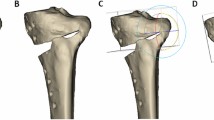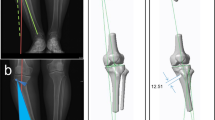Abstract
Objective
To measure the medial opening gap and examine a technique for preserving the tibial posterior slope (TPS) in open-wedge high tibial osteotomy (OWHTO) using computer-simulated three-dimensional (3D) surgery.
Materials and methods
This study included 24 symptomatic knees from 20 patients (7 men and 13 women; mean age, 67.9 years; range 54–89 years). Digital imaging and communications from computed tomography examination were applied to a 3D picture software program, and several anatomical landmarks were registered. Then, computer simulation of OWHTO as a virtual surgery was performed: the correction angle was decided to make the femorotibial angle 170°, and the TPS did not differ between pre- and postplanification. The distance between the proximal and distal cortices of the medial tibia was measured at three points, which were the anterior (AD), posterior (PD), and longest (LD) distance sites in the sagittal plane, using the 3D view, and the ratios of AD/PD and AD/LD were measured. The anteromedial opening gap was compared to the posteromedial gap and the longest distance gap at the osteotomy site. Spearman’s rank correlation coefficient test was used in statistical analysis.
Results
Mean AD/PD was 0.740 ± 0.051 (range 0.651–0.850), and mean AD/LD was 0.652 ± 0.040 (range 0.571–0.768). The correction angle was not associated with the values of both AD/PD and AD/LD.
Conclusions
Difference in AD/PD and AD/LD between each patient was regarded as a significant variation. Therefore, preoperative planification with 3D computer simulation to measure AD/PD and AD/LD may be helpful to avoid a significant increase in TPS.







Similar content being viewed by others
References
Coventry MB (1965) Osteotomy of the upper portion of the tibia for degenerative arthritis of the knee, a preliminary report. J Bone Joint Surg Am 47:984–990
Coventry MB (1998) Proximal tibial osteotomy. Orthop Rev 17:456–458
Duivenvoorden T, van Diggele P, Reijman M et al (2017) Adverse events and survival after closing- and opening-wedge high tibial osteotomy: a comparative study of 412 patients. Knee Surg Sports Traumatol Arthrosc 25:895–901
Hankemeier S, Mommsen P, Krettek C et al (2010) Accuracy of high tibial osteotomy: comparison between open- and closed-wedge technique. Knee Surg Sports Traumatol Arthrosc 18:1328–1333
Lee DC, Byun SJ (2012) High tibial osteotomy. Knee Surg Relat Res 24:61–69
Nakamura E, Mizuta H, Kudo S, Takagi K, Sakamoto K (2001) Open-wedge osteotomy of the proximal tibia with hemicallotasis. J Bone Joint Surg Br 83:1111–1115
Takeuchi R, Ishikawa H, Aratake M et al (2009) Medial opening wedge high tibial osteotomy with early full weight bearing. Arthroscopy 25:46–53
Brouwer RW, Bierma-Zeinstra SM, van Koeveringe AJ, Verhaar JA (2005) Patellar height and the inclination of the tibial plateau after high tibial osteotomy. The open versus the closed-wedge technique. J Bone Joint Surg Br 87:1227–1232
Chae DJ, Shetty GM, Lee DB, Choi HW, Han SB, Nha KW (2008) Tibial slope and patellar height after opening wedge high tibial osteotomy using autologous tricortical iliac bone graft. Knee 15:128–133
El-Azab H, Glabgly P, Paul J, Imhoff AB, Hinterwimmer S (2010) Patellar height and posterior tibial slope after open- and closed-wedge high tibial osteotomy: a radiological study on 100 patients. Am J Sports Med 38:323–329
Hanada M, Takahashi M, Koyama H, Matsuyama Y (2014) Comparison of the change in patellar height between opening and closed wedge high tibial osteotomy: measurement with a new method. Eur J Orthop Surg Traumatol 24:567–570
LaPrade RF, Oro FB, Ziegler CG, Wijdicks CA, Walsh MP (2010) Patellar height and tibial slope after opening-wedge proximal tibial osteotomy: a prospective study. Am J Sports Med 38:160–170
Smith TO, Sexton D, Mitchell P, Hing CB (2010) Opening- or closing-wedged high tibial osteotomy: a meta-analysis of clinical and radiological outcomes. Knee 18:361–368
Wright JM, Heavrin B, Begg M, Sakyrd G, Sterett W (2001) Observations on patellar height following opening wedge proximal tibial osteotomy. Am J Knee Surg 14:163–173
Hohmann E, Bryant A, Imhoff AB (2006) The effect of closed wedge high tibial osteotomy on tibial slope: a radiographic study. Knee Surg Sports Traumatol Arthrosc 14:454–459
Schaefer TK, Majewski M, Hirschmann MT, Friederich NF (2008) Comparison of sagittal and frontal plane alignment after open- and closed-wedge osteotomy: a matched-pair analysis. J Int Med Res 36:1085–1093
Dejour H, Neyret P, Boileau P, Donell ST (1994) Anterior cruciate reconstruction combined with valgus tibial osteotomy. Clin Orthop Relat Res 299:220–228
Giffin JR, Vogrin TM, Zantop T, Woo SL, Harner CD (2004) Effects of increasing tibial slope on the biomechanics of the knee. Am J Sports Med 32:376–382
Jo HS, Park JS, Byun JH et al (2018) The effects of different hinge positions on posterior tibial slope in medial open-wedge high tibial osteotomy. Knee Surg Sports Traumatol Arthrosc 26:1851–1858
Lee YS, Park SJ, Shin VI, Lee JH, Kim YH, Song EK (2010) Achievement of targeted posterior slope in the medial opening wedge high tibial osteotomy: a mathematical approach. Ann Biomed Eng 38:583–593
Moon SW, Park SH, Lee BH et al (2015) The effect of hinge position on posterior tibial slope in medial open-wedge high tibial osteotomy. Arthroscopy 31:1128–1133
Noyes FR, Goebel SX, West J (2005) Opening wedge tibial osteotomy: the 3-triangle method to correct axial alignment and tibial slope. Am J Sports Med 33:378–387
Song EK, Seon JK, Park SJ (2007) How to avoid unintended increase of posterior slope in navigation-assisted open-wedge high tibial osteotomy. Orthopedics 30:S127–S131
Yim JH, Seon JK, Song EK (2012) Posterior tibial slope in medial opening-wedge high tibial osteotomy: 2-D versus 3-D navigation. Orthopedics 35:60–63
Levine B, Fabi D, Deirmengian C (2010) Digital templating in primary total hip and knee arthroplasty. Orthopedics 33:797
Sariali E, Mauprivez R, Khiami F, Pascal-Mousselard H, Catonné Y (2012) Accuracy of the preoperative planning for cementless total hip arthroplasty. A randomised comparison between three-dimensional computerised planning and conventional templating. Orthop Traumatol Surg Res 98:151–158
Viceconti M, Lattanzi R, Antonietti B et al (2003) CT-based surgical planning software improves the accuracy of total hip replacement preoperative planning. Med Eng Phys 25:371–377
Shimizu F, Uehara M, Oatari M, Kusatsu M (2016) Three-dimensional visualization of the human face using DICOM data and its application to facial contouring surgery using free anterolateral thigh flap transfer. J Plast Reconstr Aesthet Surg 69:e1–e4
Kobayashi N, Inaba Y, Kubota S et al (2007) The distribution of impingement region in cam-type femoroacetabular impingement and borderline dysplasia of the hip with or without cam deformity: a computer simulation study. Arthroscopy 33:329–334
Yoshii Y, Kusakabe T, Akita K, Tung WL, Ishii T (2017) Reproducibility of three dimensional digital preoperative planning for the osteosynthesis of distal radius fractures. J Orthop Res 35:2646–2651
Takeuchi R, Ishikawa H, Kumagai K et al (2012) Fractures around the lateral cortical hinge after a medial opening-wedge high tibial osteotomy: a new classification of lateral hinge fracture. Arthroscopy 28:85–94
Kendoff D, Lo D, Goleski P, Warkentine B, O’Loughlin PF, Pearle AD (2008) Open wedge tibial osteotomies influence on axial rotation and tibial slope. Knee Surg Sports Traumatol Arthrosc 16:904–910
Author information
Authors and Affiliations
Corresponding author
Ethics declarations
Conflict of interest
Mitsuru Hanada, Kensuke Hotta, and Yukihiro Matsuyama declare that they have no conflict of interest.
Additional information
Publisher's Note
Springer Nature remains neutral with regard to jurisdictional claims in published maps and institutional affiliations.
Rights and permissions
About this article
Cite this article
Hanada, M., Hotta, K. & Matsuyama, Y. A computer simulation study for preserving the tibial posterior slope in open-wedge high tibial osteotomy. Eur J Orthop Surg Traumatol 30, 1285–1291 (2020). https://doi.org/10.1007/s00590-020-02703-5
Received:
Accepted:
Published:
Issue Date:
DOI: https://doi.org/10.1007/s00590-020-02703-5




